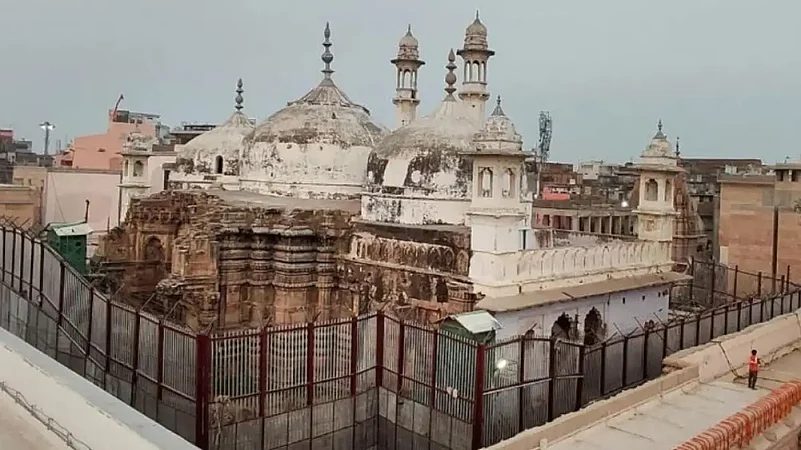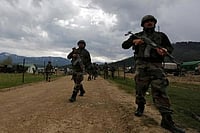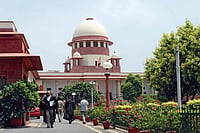The Varanasi District Court on Friday rejected the Hindu devotees' plea seeking carbon dating of a 'Shivling' found inside Gyanvapi Mosque.
The Court ruled that the plea for 'scientific investigation' cannot be allowed since the Supreme Court has ordered the sealing of the place where the 'Shivling' was found, according to legal news website Lawbeat.
In the initial phase of the case, the Court had mandated a videography survey of Gyanvapi Mosque. An object found during the survey was claimed by the Hindu petitioners to be a 'Shivling'. Four of the five original Hindu petitioners had sought the carbon dating of this object. Carbon dating is a scientific process used commonly in archaeology to assign age to objects.
Arguments on the plea seeking carbon dating were completed on Tuesday. The Gyanvapi Mosque committee had opposed the plea.
Here we explain the Gyanvapi Mosque case so far, the road ahead for it, the history of the dispute, and its broader socio-political context.
What's the current Gyanvapi Mosque case?
The present case stems from a petition by five Hindu devotees, filed in August 2021, which seeks rights to pray daily before Hindu idols on the outer walls of Gyanvapi Mosque.
In the hearing of the petition, a videography survey was ordered. During the survey, the 'Shivling' was found close to the "wazookhana" —ablution pond— in the mosque. It is this 'Shivling' whose carbon dating was sought. The mosque committee opposed this, saying it was not a Shivling but a fountain.
The following is the brief timeline of the present Gyanvapi Mosque case:
April 8 : Civil Judge (Senior Division) Ravi Kumar Diwakar orders videography survey.
April 21: The mosque committee challenges the survey order in Allahabad High Court. Their plea is dismissed. The survey starts on May 6.
May 13: The mosque committee approaches the Supreme Court to seek a stay of Varanasi court proceedings. It argued the survey violated the Places of Worship Act. The SC did not stay the survey.
May 16: The Varanasi Civil Court ordered the sealing of the area in Gyanvapi Mosque where 'Shivling' was found. It also restricted namaz inside mosque.
May 17: The Supreme Court ordered that the 'Shivling' be protected and Muslims be allowed to offer namaz inside the mosque.
May 19: The SC deferred the hearing for May 20.
May 20: The SC transferred the case from Varansi Civil Court to District Court, saying such a sensitive case was better suited for a more senior judge. It also asked the district court to first decide on the maintainability plea by the mosque committee. The earlier order on protection of 'Shivling' and rights to offer namaz by Muslims was also extended until the decision by the district court.
Sept. 12: Deciding on the issue of maintainability of plea, the Varanasi District Court rejected the challenge to the Hindu devotees' plea by the mosque committee. The court ruled that there was no question of Places of Worship Act barring this petition as merely prayer rights were being sought and the petition did not seek to change the religious character of the mosque.
Following the Sept. 12 ruling, four of the five Hindu petitioners sought the carbon dating of the 'Shivling'. The fifth petitioner did not join the petition because of fears that the object might be harmed during the process.
Previous lawsuits on Gyanvapi Mosque
The current lawsuit is not the first one to be filed regarding Varanasi's Gyanvapi Mosque.
In 1991, a petition was filed by Hindu priests to accesss the mosque and pray.
Saying that the mosque was built atop the original Kashi Vishwanath temple, the petition also sought its transfer to Hindus. It was dismissed in 1998.
In December 2019, another petition was filed in Varansi Civil Court. It sought an archaeological assessment of the Gyanvapi mosque's origins.
"The proceedings were stayed by the Allahabad High Court in February 2020. Then, despite the stay, the matter was reopened by a Varanasi Civil Court in April 2021. Fast Track Court Civil Judge (Senior Division) Ashutosh Tiwari ordered an Archaeological Survey of India investigation into the mosques origins. The mosque’s Management Committee approached the Allahabad High Court, which once again stayed the proceedings on September 9th, 2021," reported the Supreme Court Observer.
The long history of Kashi temples, mosques
The basic premise of all lawsuits is that a Hindu temple at the site was demolised in the past and a mosque was built in its place. The current petition seeking prayer rights before the idols on the outer walls of the mosque also stems from this.
The most recent round of destruction is reported from the time of Mughal Emperor Aurangzeb's reign. He ordered the demolition of the temple because he believed it as a "measure of punishment" and "centre of spreading subversive ideas", according to historian Satish Chandra.
"As a result of these orders, a number of temples such as the famous temple of Vishwanath at Banaras, and the temple of Keshava Rai at Mathura built by Bir Singh Deo Bundela in the reign of Jahangir were destroyed and mosques erected in their place," writes Chandra in his book Medieval India: From Saltanat to the Mughals.
The temple was destroyed at least two times earlier as well.
"It [Kashi Vishwanath] was first attacked by Aibak in 1194 CE, [and then] Queen Raziya (r. 1236-1240), during her short chaotic reign, appropriated the site and had a mosque constructed there," writes historian Meenakshi Jain in her book Flight of Deities and Rebirth of Temples.
The temple was rebuilt during Akbar's reign. Then it was demolished again during the reign of Aurangzeb.
As for one wall that remains, Jain notes, "A portion of the temple was intentionally retained as the rear wall of the mosque. Ironically, the mosque was known as Gyanvapi mosque, deriving its name from the sacred location on which it stood."
Today, the Gyanvapi Mosque is close to the Kashi Vishwanath Temple, owing to their long and complex history of destruction and rebuilding.
The socio-political context of Gyanvapi case
With its complex history, which brings together history, religion, and legal disputes, the case has a complex socio-political context with it as well.
During the Ram Mandir movement that picked pace in 1980s, issues of Kashi Vishwanath and Mathura's Keshava Rai temples were also raised. One of the famous slogans from the Mandir movement was: Ayodhya to bas jhanki hai, Mathura-Kashi baaki hai. It translates as "Ayodhya is only a glimpse, Mathura and Kashi are still left."
The idea behind these movements is to right historical wrongs. The opponents of this line of thought say that sticking to the past does not allow closure and paves ground for further polarisation today over events that happened hundreds of years before.
Even as Gyanvapi case continues, petitions have already been filed in Mathura.
As for the Varanasi District Court judgement on Friday, the Hindu petitioners have said they would challenge it in higher courts.


























